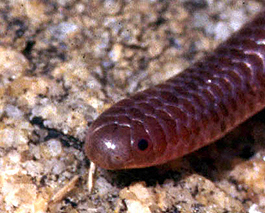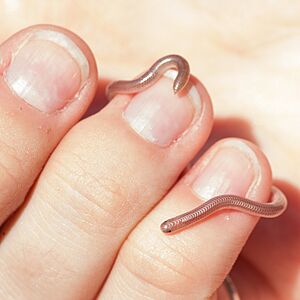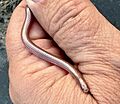Leptotyphlopidae facts for kids
Quick facts for kids Leptotyphlopidae |
|
|---|---|
 |
|
| Western blind snake, Rena humilis | |
| Scientific classification |
|
| Kingdom: | Animalia |
| Phylum: | Chordata |
| Class: | Reptilia |
| Order: | Squamata |
| Suborder: | Serpentes |
| Infraorder: | Scolecophidia |
| Family: | Leptotyphlopidae Stejneger, 1892 |
| Subfamilies | |
|
Epictinae |
|
| Synonyms | |
|
|
The Leptotyphlopidae (say "lep-toh-TY-flop-ih-dee") are a family of snakes often called slender blind snakes or thread snakes. You can find these small snakes in North America, South America, Africa, and Asia. They all live underground, burrowing through the soil, and mostly eat ants and termites.
Contents
About Slender Blind Snakes

These snakes are usually quite small. Most slender blind snakes are less than 30 cm (12 in) long. Only a couple of types, like Trilepida macrolepis and Leptotyphlops occidentalis, grow larger.
Their heads are blunt, and their bodies are shaped like cylinders. They have very smooth, shiny scales. Unlike many snakes, they don't have teeth in their upper jaw, and their upper jaw doesn't move. They also produce special chemicals called pheromones that help protect them from attacks by termites, which is important since they live near termite nests.
One of the most amazing facts about this family is that it includes what many believe is the world's smallest snake: L. carlae, discovered in 2008.
Where They Live
Slender blind snakes are found in many places around the world. In Africa, they live across the continent. In Asia, you can find them from Turkey all the way to eastern India, and also on Socotra Island.
In the Americas, they live in the southwestern United States, south through Mexico and Central America, and into South America. However, they don't live in the high Andes mountains. On the Pacific side of South America, they go as far south as coastal Peru. On the Atlantic side, they reach Uruguay and Argentina. In the Caribbean islands, they are found on the Bahamas, Hispaniola, and the Lesser Antilles.
Their Homes
Slender blind snakes can live in many different kinds of places, from very dry areas to wet rainforests. They are often found close to ant and termite nests because that's where their food is!
What They Eat
The main food for slender blind snakes is the larvae (young), pupae (developing insects), and adult ants or termites. Most species have a special way of eating: they suck out the soft insides of the insects and leave behind the hard outer shell (exoskeleton).
Reproduction
Snakes in the Leptotyphlopidae family are oviparous. This means they lay eggs.
Types of Slender Blind Snakes
The Leptotyphlopidae family is divided into two main groups, called subfamilies:
- The Leptotyphlopinae subfamily includes several groups of snakes, like Leptotyphlops, Myriopholis, and Namibiana.
- The Epictinae subfamily includes snakes found in the New World (like Epictia and Rena) and some found in Africa (like Tricheilostoma).
Images for kids
-
Leptotyphlops type species; Black thread snake (L. nigricans)
-
Rena type species; Western blind snake (R. humilis)
See also
 In Spanish: Leptotiflópidos para niños
In Spanish: Leptotiflópidos para niños
- List of leptotyphlopid species and subspecies









